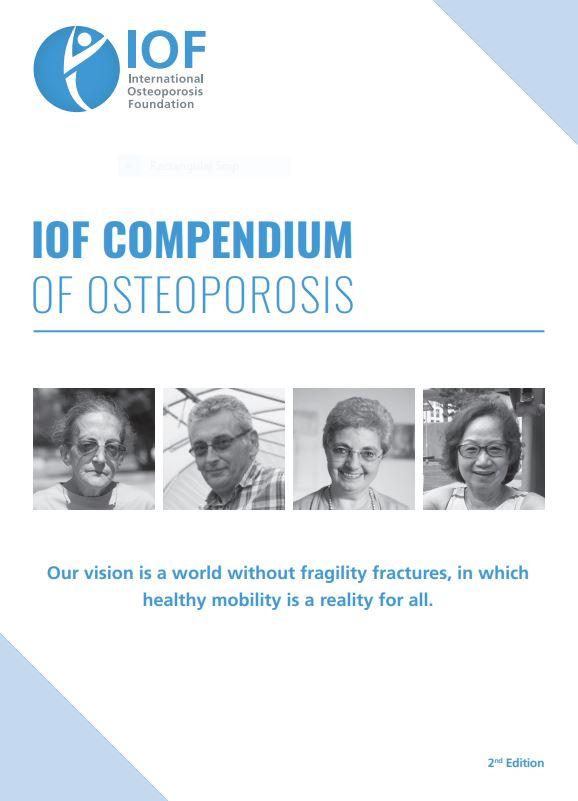Launched for World Osteoporosis Day, a new edition of the IOF Compendium of Osteoporosis highlights alarming increases in dependency ratios for older people and outlines nine global priorities for fracture prevention

Credit: International Osteoporosis Foundation
October 22, 2019 – Geneva, Switzerland – Presenting many new facts and figures, a 2nd edition of the International Osteoporosis Foundation (IOF) Compendium of Osteoporosis has been launched to mark World Osteoporosis Day.
The IOF Compendium is an authoritative reference document on osteoporosis for all key stakeholders in the field of musculoskeletal health. It provides a concise overview of the pathophysiology, risk factors, prevention and management of the disease; documents the prevalence of osteoporosis and related fractures both globally and regionally; and outlines current research on the epidemiology, mortality, health expenditure, and access to/reimbursement for diagnosis and treatment for each region of the world.
Expanding on the key priorities for action listed in the first edition, the new Compendium urges health authorities to support all stakeholders in the development of national hip fracture registries, a mechanism to benchmark patient care for hip fracture patients against clinical care standards. The data provided by a hip fracture registry can facilitate comparison between different regions and hospitals, provide better understanding of treatment results, and help accelerate equitable, high-quality care nationwide.
The new edition also draws attention to the need for improved multidisciplinary rehabilitation, which includes improvements in acute multidisciplinary care for fracture patients, in rapid secondary prevention after the first occurrence of a fracture, and in adequate ongoing care for those whose ability to function is impaired after fracture.
In 2019, for the first time, the G20 group of nations identified ageing as a global risk. UN global and regional projections, shown in the report, reveal an alarming increase in dependency ratios for older people, i.e. the ratio of the population aged 65 and over to the population aged 15-64. The Republic of Korea provides one of the starkest illustrations of the demographic shift that is projected to occur, rising from 10 people aged 65 and over per 100 people of working age in 2000, to 66.3 per 100 workers in 2050. Europe will remain the world’s oldest region with a ratio of 48.7 per 100 by 2050. Latin America too is ageing rapidly. The most populous country, Brazil, will see a shift from a low ratio of 7.8 per 100 in 2000 to 36.7 per 100 in 2050.
IOF President Professor Cyrus Cooper stated:
“The dependency ratios clearly show that maintaining mobility and independence in older populations is increasingly a matter of necessity. Fractures due to osteoporosis are common, affecting approximately one in three women and one in five men aged 50 and over worldwide. Loss of function and independence among survivors of hip fractures is profound, with 40% unable to walk independently and 60% requiring assistance a year later. Because of these losses, up to 33% are totally dependent or in a nursing home in the year following a hip fracture.”
The Compendium now presents data from the 2018 IOF report ‘Broken bones, broken lives’ which projects that in six European countries (France, Germany, Italy, Spain, Sweden and the UK) there will be a 23% increase in fragility fractures from 2017 to 2030, with fracture-related costs rising from 37.5 billion to 47.4 billion euros over this time period.
Professor Cooper added: “Global efforts must be made to tackle the impending fragility fracture crisis. I urge all concerned stakeholders to make use of the IOF Compendium of Osteoporosis as a resource to help drive action for prevention in their countries.”
A principal priority listed in the Compendium is the need to implement Fracture Liaison Services (FLS) in all clinics that treat fracture patients. These services are a proven way to effectively identify and manage patients at high risk of secondary fractures, thus reducing hospital re-admissions and healthcare costs. The IOF Capture the Fracture® website provides further information and resources to assist clinics and hospitals which aim to set up new FLS, or improve existing FLS, in all regions of the world.
The IOF Compendium of Osteoporosis, together with other resources for the public, patients, and healthcare professionals, is available on the World Osteoporosis Day website.
###
About World Osteoporosis Day (WOD):
Marked annually on October 20, the campaign calls for global action to fight osteoporosis and related fractures worldwide. http://www.
WOD Official Partners: Sunsweet, Medtronic, Sandoz
About IOF:
The International Osteoporosis Foundation is the world’s largest non-governmental organization dedicated to bone health and osteoporosis prevention. @iofbonehealth http://www.
Media Contact
L. Misteli
[email protected]




